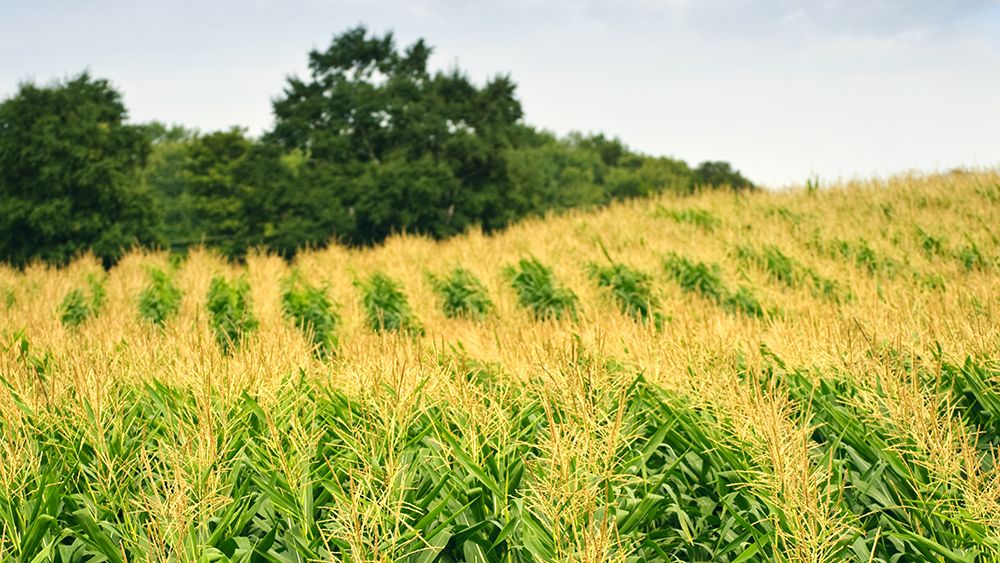Corn is Demanding a Lot of Water and Our Soils Should Have It
Corn is Demanding a Lot of Water and Our Soils Should Have It

According to the July 6, 2025 USDA Crop Progress Report, 40% of corn in Kentucky had reached silking and 4% had reached the dough stage. From the earliest appearance of tassels until pollination is complete corn demands the most water and is the most sensitive to a lack of water. The corn at dough stage is on the other side of the peak water demand. Corn will need adequate water all the way to black layer (R6 growth stage or physiological maturity) but its demand declines at about the blister stage (R2) or shortly after.
Some estimates place corn water use as high as 0.33 inches per acre per day from tassel until blister. Since the corn canopy fully shades the soil, this 0.33 inches per acre is transpired from the crop into the atmosphere. Water moving from the soil into the roots and through the plant helps it develop, grow and maintain plant functions. A lack of water disrupts nutrient uptake, temperature regulation and stops or slows growth.
For much of the corn in Kentucky these past few weeks, water use was likely at 0.33 inches per acre per day with air temperatures exceeding 86 degrees Fahrenheit most days since June 21st. For example, Christian County, KY has had ten days above 86 F since June 21. In Simpson County, every day but one has been above 86°F. In Hardin County, every day since June 21 has been above 86°F.
Most pollen drop occurs in the morning and most fields have had adequate water to this point. Based on these factors, pollination should have been successful in fields already pollinated. For corn currently pollinating, we should expect good seed set as well.
Corn in this region will require roughly 20 to 25 inches of water from planting to black layer and about 10 to 12 inches from silking to black layer. The typical Crider silt loam soil will hold about 6 to 8 inches of plant available water at field capacity. Indications are that most soils across the state are holding enough water to complete pollination and get corn through early seed development. These fields will need timely rains to complete seed fill, but all things considered, much of the corn crop is favorably positioned.
For the 60% of corn that was not at silking on July 6th, that ranges from V2 (two fully emerged leaves) to V14 (just a few days before tasseling and silking) across the state. The corn will grow rapidly through the vegetative stages. Younger corn will demand less water and that water demand will increase the closer it approaches tassel and silking. Corn in those fields should not be suffering from a lack of water for most of the state. Those fields with younger corn will need a few more timely rains than corn at silking to finish out the crop.
Any corn that is suffering from sidewall compaction and subsurface compaction is not in a good position. Roots restricted mostly to the seed furrow or roots restricted to shallow depth in the field will not be able to access as much water. These plants are at great risk for running out of water. In fact, right now rolling corn leaves are likely due to soil compaction.
If soil compaction is suspected, use a tile spade to dig out some corn plants. Pretend that you are trying to pot that corn plant into a 5-gallon bucket and dig an area large enough to fill that bucket. Once you have the corn plant out of the soil, you can either gently knock soil off the roots with the spade or use a garden hose to wash the soil away. Roots should be growing mostly in a half globe shape, and most of roots should be in the upper 8 inches or so with some roots extending beyond that. If all the roots look like a mohawk or clearly bend at 2 to 6 inches, then those plants are suffering from compaction. If corn roots are severely limited by compaction, there is no economically sound way to help those plants recover at this point. A gentle 1 inch of rain occurring over about a 4-hour period every 5 to 7 days is the only thing that can save those plants.
Sources
Kentucky Mesonet. https://www.kymesonet.org/
Kranz, Irmak, Donk, Yonts and Martin. 2008. Irrigation Management for Corn. G1850. University of Nebraska-Lincoln.
Lee, C.D. 2011. AGR-202. Corn Growth Stages and Growing Degree Days: A Quick Reference Guide. Kentucky Cooperative Extension. Lexington. https://publications.ca.uky.edu/sites/publications.ca.uky.edu/files/agr202.pdf
Nielsen, R.L. 2025. Tassel emergence & pollen shed. Corny News Network. http://www.kingcorn.org/news/timeless/Tassels.html
Citation: Lee, C., 2025. Corn Demands More Water Right Now and Many of our Fields Have It. Kentucky Field Crops News, Vol 1, Issue 7. University of Kentucky, July 11, 2025.

